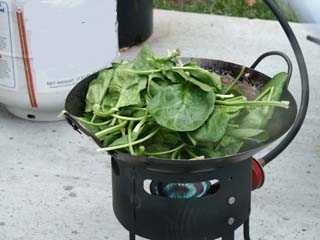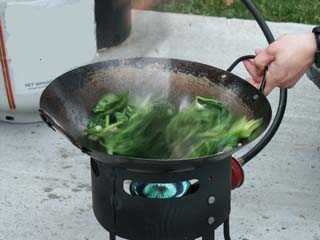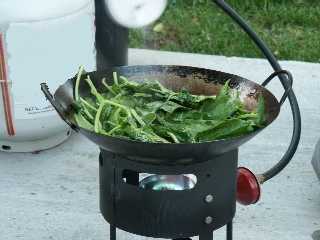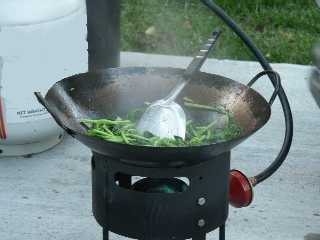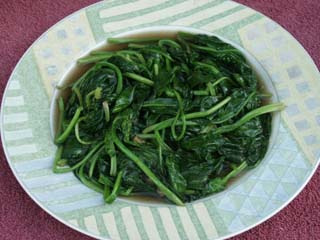The key to great stir fry cooking is to control two critical factors:
Our outdoor stir fry stove gives you easy access of high temperature when you want it, and as you want it — temperature on-demand. Yes, you can master the stir fry cooking technique with a little experimentation and practice — there is no secret recipe here. In time, you will become a master chef with your own style of stir fry cooking, and you will be able to produce good-tasting and healthy stir fried dishes that you, your family and your friends will enjoy. So get some of your favorite ingredients, and let’s get started. Stir fried spinachThe term stir fried as applied to any green vegetable is a misnomer. Folks, we are not talking about fried chicken here — you cannot immerse the vegetable in a pot of hot oil. Instead, our way of cooking green pepper on our outdoor stir fry stove uses very little cooking oil, retains much of the vitamin in the raw food, and keeps the fresh taste and color of the vegetable. No wonder that green vegetables are perhaps the most popular ingredients in stir fry cooking! Ingredients:Green spinach (a bundle), vegetable oil (2 tablespoons). Spices: Salt; Optional: garlic (slices or powder). Preparing the ingredients. Unlike stewing where the cook time is long (hours) and you can sort of prepare the ingredients and cook at the same time, stir-fry requires you to prepare the ingredients BEFORE you start the fire on the stove, because — the cooking will be over in about a couple of minutes, and you won’t have time to wash or cut the spinach when the fire has started. The short cooking time in stir fry is why the vital nutrients in the vegetable are retained as well as the freshness and color. First, wash and rinse the spinach using tap water. You don’t need to dry the water completely after washing; just drip water out — a little bit of water on the leaves and stems of the vegetable is perfectly fine in stir fry. There is no need to cut the spinach, because the spinach leaf will shrink in half after cooking.Second, if you like garlic in spinach, like the usual Chinese food of stir fried spinach, cut a garlic into thin slices using a knife, or grind the garlic in your favorite garlic grinder. Skip the garlic if you don’t like it. Start the outdoor stir fry stove. Follow the instructions to hook up the stove and the propane gas tank, and start the fire. Place the wok or frying pan over the flame. Wait a few seconds till the water (if there is any) in the wok or frying pan has evaporated under the heat. Cook.
Summary and further tipsEvery step in stir-fry happens fast — there is hardly any time for you to read this cooking instructions while you are cooking. Just remember the following steps: Add oil (make sure water has completely evaporated from the frying pan before you do), wait for high heat, add vegetable, stir fry, add salt, and done! If your spinach looks soggy, probably your temperature isn’t high enough, or you over-cooked it — the spinach stayed in the pan for too long. Low temperature is a common cause of soggy output — that’s why you need our patented, high-powered outdoor stir fry stove! If the spinach stayed in the pan for too long, you can see lots of water in the pan — water from the spinach and other green vegetables which contain mostly water (H2O) by weight!Don’t worry if your first try isn’t completely successful. The good news is that you can still eat the spinach whether or not it is undercooked (think about it as in salad) or overcooked — it just won’t taste too good. With some experimentation, you will gain knowledge of temperature and timing by simply looking at the softness of the vegetable in the frying pan. |



